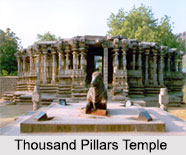 The Thousand Pillars Temple is located in the town of Hanamakonda, Warangal district, in the Telangana state of India, at a fair distance of 150 km from the city of Hyderabad. Also known as Rudreshwara Swamy, it is an ancient Hindu temple dedicated to Lord Shiva, Lord Vishnu and Surya. The 3 shrines inside the temple are called the Trikutalayam. The temple stands on a platform of 1 metre at the base of the Hanamakonda hill. Considered to be one of the principal monuments in India, this temple is a major tourist attraction at Hanamkonda.
The Thousand Pillars Temple is located in the town of Hanamakonda, Warangal district, in the Telangana state of India, at a fair distance of 150 km from the city of Hyderabad. Also known as Rudreshwara Swamy, it is an ancient Hindu temple dedicated to Lord Shiva, Lord Vishnu and Surya. The 3 shrines inside the temple are called the Trikutalayam. The temple stands on a platform of 1 metre at the base of the Hanamakonda hill. Considered to be one of the principal monuments in India, this temple is a major tourist attraction at Hanamkonda.
History of Thousand Pillars Temple
The Thousand Pillars was built under the patronage of the Kakatiya ruler, Rudra Deva in 1163 AD. The temple is an amalgamation of Kakatiya, Chalukya and Kadamban architecture and 12th century sculptures. The Thousand Pillars temple is almost 855 years old and has a rich glorious history.
The temple was destroyed by the Tughlaq dynasty during their invasion of South India. The presence of a thousand pillars in the temple never prevents its visitors from viewing the idol of the deity in the other temple. Currently, the pillars of Thousand Pillars Temple have been extricated by engineers who have discovered a gigantic mass of sand underneath all the pillars. It was wet sand which had accumulated due to a pipe connection that source a local water-body called Bhadrakali Cheruvu.
Architecture of Thousand Pillars Temple
The temple stands out to be a masterpiece being one of the finest specimens of Kakatiya architecture and sculpture. The entrance gateways, ceilings and pillars of the structure are all embellished with elaborate and exquisite carvings. The structural decorations around the walls of the temple depict human activities, showing fresh charms, elegance and an almost metallic finish. The perforated screen pattern on the flanks of the door jambs, female figures in various dancing poses, all display the supreme workmanship accomplished by the sculptor of that age. The temple with thousand pillars and the unique star shape of the temple is an architectural marvel in itself and is among the ancient temples of Telangana. Carved out of a single stone, the black basalt monolith of Nandi, the bull, presents a glimpse into the artistic finesse of the bygone eras. The richly carved pillars and the rock-cut elephants are the main component of the temple. Surrounded by a well-maintained lush green garden, the temple precincts are strewn with several lingam shrines. The temple is now recognized as a heritage site under UNESCO and is managed by the Archaeological Survey of India.
Visiting Information on Thousand Pillars Temple
The Warangal railway station is at a distance of 6 km from the temple. The nearest airport to the temple is the Rajiv Gandhi International Airport at Hyderabad.





















